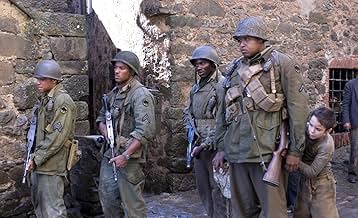NOTE IMDb
6,1/10
19 k
MA NOTE
Italie, 1944. L'histoire de quatre soldats américains noirs piégés dans un village de Toscane pendant la Seconde Guerre mondiale.Italie, 1944. L'histoire de quatre soldats américains noirs piégés dans un village de Toscane pendant la Seconde Guerre mondiale.Italie, 1944. L'histoire de quatre soldats américains noirs piégés dans un village de Toscane pendant la Seconde Guerre mondiale.
- Récompenses
- 1 victoire et 10 nominations au total
Lidia Biondi
- Natalina
- (as Lydia Biondi)
Histoire
Le saviez-vous
- AnecdotesSamuel L. Jackson turned down the offer to play as Corporal Hector Negron to work on Harcelés (2008).
- GaffesWhen the professor examines the marble head he recognizes it as the "Primavera" from Santa Trinità in Florence. He assumes it is by Bartolomeo Ammannati, but the bridge is by Ammannati; the sculpture is by Pietro Francavilla.
- Citations
Livingston: Safety is the greatest risk of all, because safety leaves no room for miracles and miracles are the only sure thing in life.
- Bandes originalesFaccetta Nera
Written by Gustavo Cacini (as Cascini) / Giuseppe Micheli (as Micheli) / Vincenzo Raimondi / Arnaldo Stazzonelli (as Stazzonelli)
Edizioni Bixio C.E.M.S.A.
Commentaire à la une
A funny thing happens when you're counted among the preeminent talents in any contemporary art form: Everything you do must approach sublime... or else. Something less funny happens when your art is as socially outspoken as Spike Lee's body of work: Folk wait with baited breath to name every shred of detail that marks your work as somehow less than sublime. And in so doing, they ever miss the forest for the trees.
Lee's latest "joint," MIRACLE AT ST. ANNA, based on James McBride's novel of the same name, no doubt will suffer from such deconstruction, some of which will be justified. At 160+ minutes, the fictional recollection of four black American WWII soldiers who get trapped in an Italian village during a German insurgence, can wax tedious. And Lee's defaulting to certain conventions of the war genre and his own signature style occasionally comes off forced, sentimental, even ridiculous. After, say, the 10th close-up of a slain human -- eyes still open in horror -- we may not need to see an 11th, 12th, 13th. And any casual student of cinema might spot Lee's attempted tear-jerker ending a la CINEMA PARADISO coming a mile away.
Then there are the technical shortcomings of personnel who should know better: A score by Terence Blanchard is uncharacteristically overwrought; cinematography by Matthew Libatique is alternately breathtaking and obtuse; and a self-adapted screenplay by McBride suffers from a conspicuously uncommitted point of view. But, indeed, what may most undercut any visceral charm of MASA is at once admirably realistic: The film's characters aren't particularly moving in their conflicted natures and utter lack of romance. Only a visionary Italian boy, played beautifully by newcomer Matteo Sciabordi, and the black American soldier who befriends him, played by the hulking Omar Benson Miller, elicit any real sympathy.
All told, the numerous missteps do not seriously undercut a captive tale of humans -- white, black and brown -- who find themselves thrown into a hell not of their making and forced to juggle universal sensibilities with the duties of their divergent identities. In this regard, Lee's latest shows marked progress: Gone are the one-sided depictions of whites. Fascist-era native Italians are shown here in all their warring complexity; American actor D.B. Sweeney plays a key, if understated, role as a white U.S. colonel opposed to the exploitation of the all-black 92nd Army Division; even Nazi stormtroopers here are given back a modicum of humanity. Neither is the African American experience sanctified: Actor Michael Ealy's preacher-turned-soldier character is equal parts charming and vile; and one pre-Civil Rights-era American flashback begs the question of what line separates hero and villain. If one is willing to forgive the imperfect details from a filmmaker who has proved capable of better, the aggregate statement is hardly ineffectual.
Lee's real victory here shouldn't be missed. MASA does not rise to the level of the best of the genre. Neither is it worthy to be called the definitive tribute to an unsung 92nd Army Division or the souls lost at Sant'Anna di Stazzema. But it is always watchable, always interesting -- and as an engaging enough mystery film and thoughtful ensemble piece with an important, forgotten corner of human failure as backdrop, it succeeds.
Lee's latest "joint," MIRACLE AT ST. ANNA, based on James McBride's novel of the same name, no doubt will suffer from such deconstruction, some of which will be justified. At 160+ minutes, the fictional recollection of four black American WWII soldiers who get trapped in an Italian village during a German insurgence, can wax tedious. And Lee's defaulting to certain conventions of the war genre and his own signature style occasionally comes off forced, sentimental, even ridiculous. After, say, the 10th close-up of a slain human -- eyes still open in horror -- we may not need to see an 11th, 12th, 13th. And any casual student of cinema might spot Lee's attempted tear-jerker ending a la CINEMA PARADISO coming a mile away.
Then there are the technical shortcomings of personnel who should know better: A score by Terence Blanchard is uncharacteristically overwrought; cinematography by Matthew Libatique is alternately breathtaking and obtuse; and a self-adapted screenplay by McBride suffers from a conspicuously uncommitted point of view. But, indeed, what may most undercut any visceral charm of MASA is at once admirably realistic: The film's characters aren't particularly moving in their conflicted natures and utter lack of romance. Only a visionary Italian boy, played beautifully by newcomer Matteo Sciabordi, and the black American soldier who befriends him, played by the hulking Omar Benson Miller, elicit any real sympathy.
All told, the numerous missteps do not seriously undercut a captive tale of humans -- white, black and brown -- who find themselves thrown into a hell not of their making and forced to juggle universal sensibilities with the duties of their divergent identities. In this regard, Lee's latest shows marked progress: Gone are the one-sided depictions of whites. Fascist-era native Italians are shown here in all their warring complexity; American actor D.B. Sweeney plays a key, if understated, role as a white U.S. colonel opposed to the exploitation of the all-black 92nd Army Division; even Nazi stormtroopers here are given back a modicum of humanity. Neither is the African American experience sanctified: Actor Michael Ealy's preacher-turned-soldier character is equal parts charming and vile; and one pre-Civil Rights-era American flashback begs the question of what line separates hero and villain. If one is willing to forgive the imperfect details from a filmmaker who has proved capable of better, the aggregate statement is hardly ineffectual.
Lee's real victory here shouldn't be missed. MASA does not rise to the level of the best of the genre. Neither is it worthy to be called the definitive tribute to an unsung 92nd Army Division or the souls lost at Sant'Anna di Stazzema. But it is always watchable, always interesting -- and as an engaging enough mystery film and thoughtful ensemble piece with an important, forgotten corner of human failure as backdrop, it succeeds.
- Laurlcrown
- 23 sept. 2008
- Permalien
Meilleurs choix
Connectez-vous pour évaluer et suivre la liste de favoris afin de recevoir des recommandations personnalisées
Détails
- Date de sortie
- Pays d’origine
- Site officiel
- Langues
- Aussi connu sous le nom de
- Miracle at St. Anna
- Lieux de tournage
- Sociétés de production
- Voir plus de crédits d'entreprise sur IMDbPro
Box-office
- Budget
- 45 000 000 $US (estimé)
- Montant brut aux États-Unis et au Canada
- 7 919 117 $US
- Week-end de sortie aux États-Unis et au Canada
- 3 477 996 $US
- 28 sept. 2008
- Montant brut mondial
- 9 333 654 $US
- Durée2 heures 40 minutes
- Couleur
- Mixage
- Rapport de forme
- 2.39 : 1
Contribuer à cette page
Suggérer une modification ou ajouter du contenu manquant

Lacune principale
By what name was Miracle à Santa Anna (2008) officially released in India in English?
Répondre




























